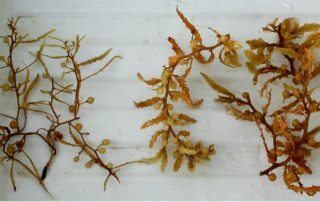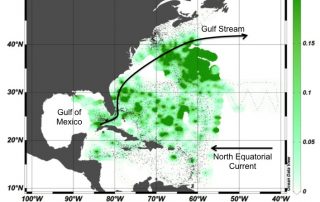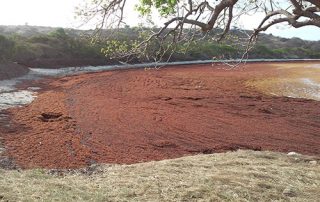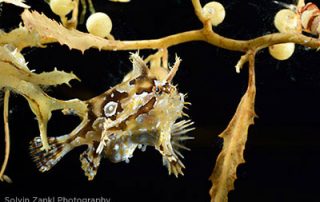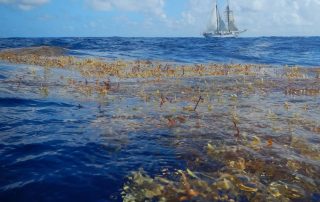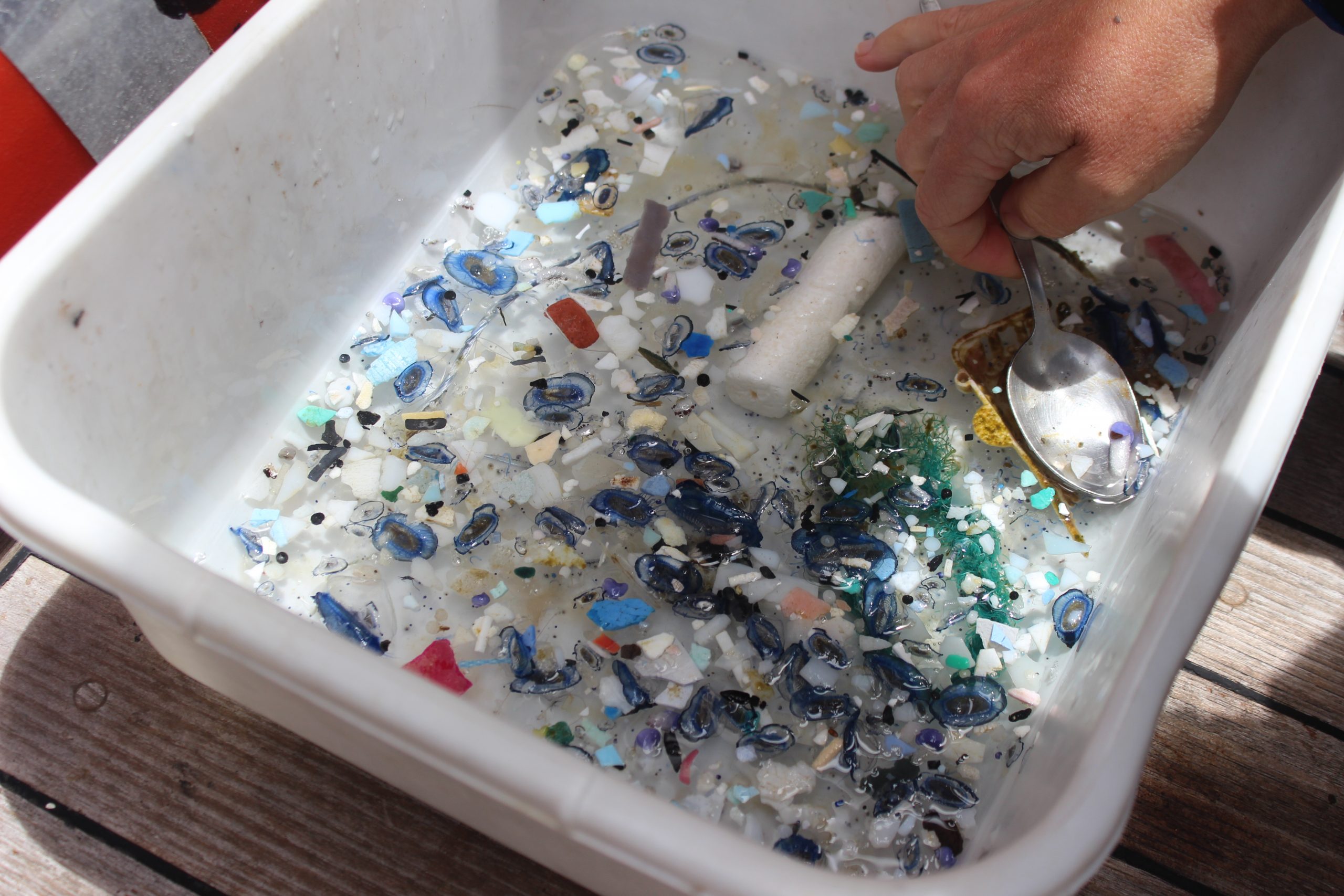Sargassum Ecosystem
Research @ SEA
Sargassum Ecosystem
Pelagic Sargassum is a macroalgae that drifts at the ocean surface, creating a unique and ecologically-significant marine ecosystem. Accumulations of Sargassum, whether they be isolated clumps or aggregated long windrows or mats covering 100’s of square meters, serve as a food source, nursery for juveniles, spawning ground and/or protective habitat for diverse invertebrate, fish, turtle and seabird species at various points of their life cycle.
For over 45 years, SEA has been documenting Sargassum species, abundance and distribution along repeated cruise tracks through the Sargasso Sea, Caribbean Sea and Gulf of Mexico. Recent investigations include the associated epibiont and mobile fauna communities, seasonal and interannual variability in distribution, and extraordinary Caribbean inundation events. SEA students, faculty and collaborators use a variety of tools to examine Sargassum itself and its hosted organisms, from field observations to morphological metrics to molecular analyses of diversity. Marine spatial planning and policy initiatives working to conserve the Sargasso Sea ecosystem also benefit from SEA students’ contributions and creative ideas. Seeking to share Sargassum research beyond the scientific community, SEA faculty scientists have taken part in many outreach events and were featured on the Meet the Ocean podcast.

Taxonomy
Historically, only two species of pelagic Sargassum were recognized in the North Atlantic: S. natans and S. fluitans. However, field collections via dip net and surface net tow combined with morphometric and genetic analyses by SEA scientists have identified distinct forms of both species. Presence or absence of thorns on the stem distinguishes between species: S. natans has smooth stems while S. fluitans has thorns. Within a species, blade and float attributes differ widely among forms – S. natans I has long, narrow blades and floats frequently adorned with an apical spine whereas S. natans VIII has long, wide blades with floats that rarely exhibit a spine. Preliminary observations indicate that a third form, S. natans II, can be identified by blade width between that of S. natans I and S. natans VIII and floats adorned with a spine. S. fluitans III has short, compact blades and no spines on the floats. Because Sargassum forms have discrete but overlapping ranges, correct field identification through visual study is critical for addressing questions of distribution, evolution, and connectivity between geographic regions. Genetic tools developed by SEA researchers distinguish morphotypes and further resolve phylogenetic relationships among Sargassum specimens.
SEA faculty and collaborators: Jeff Schell (SEA), Deb Goodwin (SEA), Kerry Whittaker (SEA), Amy Siuda (Eckerd College)
Distribution patterns
SEA’s 45-year plankton net tow data set indicates that distinct seasonal and interannual distribution patterns exist for each Sargassum species and morphological form. S. natans I is most commonly found in the central Sargasso Sea while S. natans VIII is often seen in the tropical Atlantic and Caribbean, and S. natans II is most frequent in the western Caribbean. S. fluitans III is broadly distributed across the Gulf Stream, North Equatorial Current, and Caribbean in addition to the Sargasso Sea. SEA field observations complement satellite detection methods by providing species identification and finer spatial resolution.
SEA faculty and collaborators: Jeff Schell (SEA), Deb Goodwin (SEA), Amy Siuda (Eckerd College)

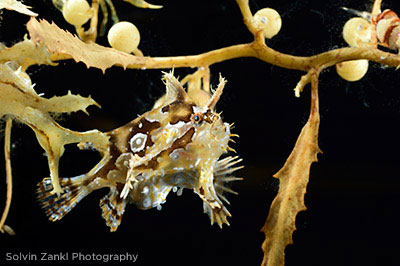
Community of organisms
A uniquely adapted pseudo-benthic community of organisms lives among the dense vegetation of each pelagic Sargassum clump, including common epifauna such as hydroids and mobile fauna such as shrimp, snails and crabs. SEA scientists and students seek to understand factors affecting the diversity and composition of this community, such as host species, genetic connectivity, geographic location, clump size and clump aggregation/dispersion pattern. Both visual/microscope-aided identification and genetic population analyses are utilized. Preliminary studies reveal that each Sargassum species and morphological form harbors a unique assemblage of organisms. Further, emerging SEA research suggests that the genetic structure of epibiont species could help explain questions of Sargassum origin and distribution.
SEA faculty and collaborators: Jeff Schell (SEA), Deb Goodwin (SEA), Kerry Whittaker (SEA), Amy Siuda (Eckerd College), Annette Govindarajan (WHOI), Lindsay Martin, Madelyn Taylor
Inundation events
During 2011-2012, 2014-2015, and again in 2018, pelagic Sargassum washed ashore in unprecedented quantities throughout the tropical Atlantic, including on many Caribbean islands. Once-pristine tourist beaches were covered by meters of stranded seaweed. Researchers at SEA discovered the Sargassum that inundated the Caribbean in 2014-2015 was the previously-rare form S. natans VIII, originating in the northern tropical Atlantic region. Inundation events have ecological consequences at multiple scales, such as impacts to Sargassum mobile fauna communities, dependent fisheries and iconic species, and coastal ecosystem function.

Papers and Publications
Hu, C., B. Murch, B. Barnes, M. Wang, J, Marechal, J. Franks, D. Johnson, B. LaPointe, D. Goodwin*, J. Schell* and A. Siuda*, 2016. Sargassum watch warns of incoming seaweed. EOS 97. doi: 10.1029/2016EO058355
Schell J.*, D. Goodwin*, and A. Siuda*. 2015. Recent Sargassum inundation events in the Caribbean – Shipboard observations establish baseline and reveal dominance of a previously rare form. Oceanography 28, 8-10. doi: 10.5670/oceanog.2015.70
Stoner*, A. and H. Greening, 1984. Geographic variation in the macrofaunal associates of pelagic Sargassum. Mar. Ecol. Prog. Ser. 20, 185-192. doi: 10.3354/meps020185
Butler, J. and A. Stoner*, 1984. Pelagic Sargassum: Has its biomass changed in the last 50 years? Deep Sea Res. Pt. A 31, 1259-1264. doi: 10.1016/0198-0149(84)90061-X
Stoner*, A., 1983. Pelagic Sargassum: Evidence for a major decrease in biomass. Deep Sea Res. Pt. A 30, 469-474. doi: 10.1016/0198-0149(83)90079-1
Wu, H., 2017. North Atlantic morphometrics of three Sargassum species and their distribution in the fall 2017. Unpublished student research paper, Class C-275, Sea Education Association, Woods Hole, MA.
Tyrrell, S., 2015. Sargassum species distribution in the North Atlantic. Unpublished student research paper, Class C-257, Sea Education Association, Woods Hole, MA.
Wooster, S., 2015. Sargassum community comparison between isolated clumps and windrows. Unpublished student research paper, Class C-257, Sea Education Association, Woods Hole, MA.
Disbrow, M., 2015. Community composition on three Sargassum morphological forms. Unpublished student research paper, Class C-257, Sea Education Association, Woods Hole, MA.
Matthews, T., B. Stockdale and M. Howard, 2013. Zoogeography of floating Sargassum in the Caribbean. Unpublished student research paper, Class C-250, Sea Education Association, Woods Hole, MA.
Bishop, E. and A. Mackie-Donnelly, 2013. Investigating Sargassum’s distribution pattern: A pelagic seaweed’s relation to plastic and epifauna in the North Atlantic. Unpublished student research paper, Class C-249, Sea Education Association, Woods Hole, MA.
Urban, E., 2012. Sessile epibiont variety and abundance as a method of correlating Sargassum age and geographic location in the Sargasso Sea. Unpublished student research paper, Class C-243, Sea Education Association, Woods Hole, MA.
Pinheiro, V., 2012. The role of Sargassum fluitans and S. natans in the ontogeny of Anguillid leptocephali in the Sargasso Sea. Unpublished student research paper, Class C-240, Sea Education Association, Woods Hole, MA.
Siuda, A.^, D. Goodwin* and J. Schell*, 2018. Identification, in situ observations of distribution, and mobile fauna community composition of the common Sargassum morphotypes. The French-American Workshop on Sargassum (invited participants), hosted by the Office for Science & Technology of the Embassy of France in the United States, the French National Research Institute for Sustainable Development, and Texas A&M University (TAMU). Galveston, TX.
Wrinn, C.^, J. Schell*, D. Goodwin* and A. Siuda^, 2016. Taxonomic guide to pelagic Sargassum in the Caribbean Sea and North Atlantic. 69th Annual Gulf and Caribbean Fisheries Institute Conference, Grand Cayman.
Taylor, M.^, A. Siuda^, D. Goodwin*, G. Huston^ and J. Schell*, 2016. Biogeographic and temporal changes in mobile fauna community on pelagic Sargassum in the Caribbean Sea, 2015-2016. 69th Annual Gulf and Caribbean Fisheries Institute Conference, Grand Cayman.
Schell, J.*, D. Goodwin* and A. Siuda^, 2016. Unprecedented proliferation of novel pelagic Sargassum form has implications for ecosystem function and regional diversity in the Caribbean. Ocean Sciences Meeting, New Orleans, LA.
Martin L.^, J. Schell*, D. Goodwin*, D. Biggs and A. Siuda*, 2016. Sargassum-associated mobile fauna communities in the Caribbean, Gulf of Mexico and Sargasso Sea. Ocean Sciences Meeting, New Orleans, LA.
Schell, J.*, D. Goodwin* and A. Siuda*, 2015. Shipboard observation of pelagic Sargassum spp. reveals proliferation of a rare form and differences in associated mobile fauna community structure. 68th Gulf and Caribbean Fisheries Institute Conference, Panama City, Panama.
Schell, J.*, 2014. Drifting oases of life in the Sargasso Sea. Fish, fishing and fisheries. Cataumet Schoolhouse Summer Series, Cataumet, MA.
Goodwin, D.*, J. Schell* and A. Siuda*, 2014. Sargassum natans and S. fluitans exhibit geographically distinct distributions in a 20-year neuston net dataset from the western North Atlantic. Ocean Sciences Meeting, Honolulu, HI.
Siuda, A.* and D. Goodwin*, 2013. Sargassum sp. distributions in the western North Atlantic – implications for conservation and management. BioNES Meeting, Bristol, RI.
Broache, A., J. Schell*, D. Goodwin* and A. Siuda*, 2016. Seaweed invasion. Ocean Watch.
Siuda, A.*, 2011. Summary of Sea Education Association long-term Sargasso Sea surface net data. Sargasso Sea Alliance Science Report Series, No. 10, 18 pp.
Latest Research News
SEA’s Dr. Kara Lavender Law: collaborating to solve ocean plastic pollution
A new report, "The future of ocean plastics: designing diverse collaboration frameworks," coauthored by SEA's Research Professor of Oceanography Kara Lavender Law, was [...]
SEA Plastics Lab Launches New Website
This week, the SEA Plastics Lab launched a new website intended to be a valuable resource for those interested in learning more about [...]
Dr. Jeff Schell Receives Henry L. and Grace Doherty Chair of Ocean Studies
SEA Professor of Oceanography Jeff Schell has been named the inaugural recipient of the Henry L. and Grace Doherty Chair of Ocean [...]


